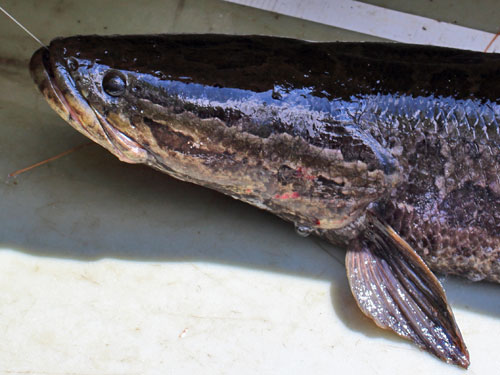
The northern snakehead is an invasive species of freshwater fish that has become established in parts of the USA.
Northern snakeheads prefer slow moving rivers, swamps, and ponds. They are often found around spatterdock, hydrilla, and other dense vegetation.
The Chesapeake Bay watershed is known for northern snakeheads. After establishing breeding populations in the Potomac River, snakeheads began a slow but steady expansion throughout the estuary.
In recent years, catches of northern snakeheads have become more common in the Susquehanna and Delaware watersheds, with snakeheads moving far upriver and into the Schuykill and other tributaries.
Northern snakeheads have also established populations in Arkansas. Hotspots in Arkansas include the White River National Refuge, Merrisach Lake, Big Piney Creek, and along the Mississippi River.
More recently, the species have been reported in Missouri in St. Francis River watershed. Scattered catches have been reported in other areas east of the Mississippi.
Northern Snakehead Facts
Northern snakeheads are fast growing fish that can reach lengths of 36 inches or more and weigh almost 20 pounds.
Northern snakeheads have a coating of slime which makes them difficult to control in the water as well as when landed. They are strong swimmers and will bite when provoked.
Northern snakeheads feed primarily on small fish, but will eat almost anything.
Northern snakeheads are reproductive by age 2 or 3 and may spawn several times between April and August. Adults prepare nests made of vegetation. Both parents guard eggs and newly hatched young. After leaving the nest area, young snakeheads travel in tightly formed “balls” which can be seen near the surface.
Federal law prohibits the transport of live northern snakeheads into the U.S. or across State lines.
Despite its reputation as a potentially harmful invasive species, the northern snakehead has become an important sport and food fish in some locations.
Fishing Techniques
Anglers employ a mixed bag of techniques for catching northern snakeheads. In some locations, live baits are preferred, especially mummichogs, small sunfish, shiners, and other baitfish. Live baits are usually suspended under a float at a range of depths.
Casting artificial lures is popular in most areas, especially near vegetation, downed timber, or other structure. Effective lures include artificial frogs, soft plastics, inline spinners, buzzbaits, chatterbaits, jigs, and others.
When using lures for catching northern snakeheads, anglers must often make selections based on the habitat that will be targeted. When fishing around spatterdock or other heavy vegetation, weedless lures are often essential.
Landing snakeheads requires special skills and equipment. Anglers use gloves, landing nets, lip grabbers, or other gear to subdue fish and prevent being bitten.
Northern snakeheads are also taken by bowfishing, spearing, and other alternative fishing methods.